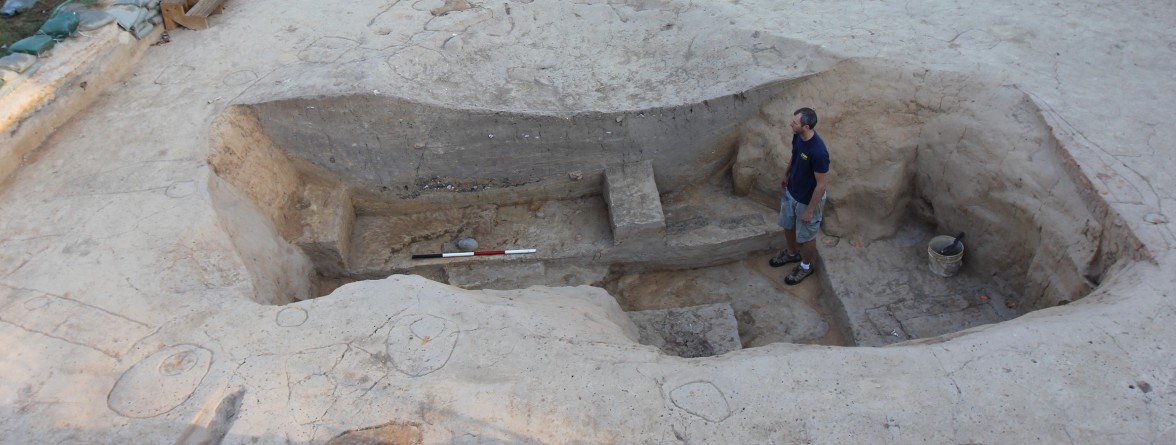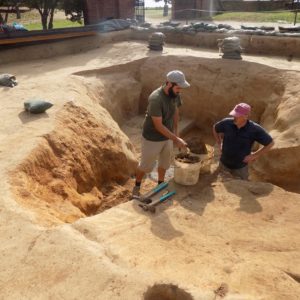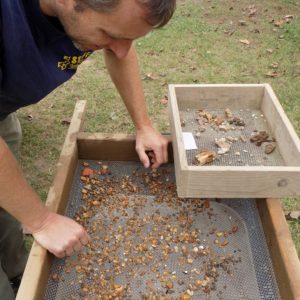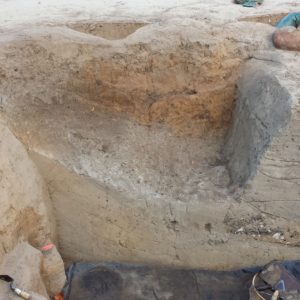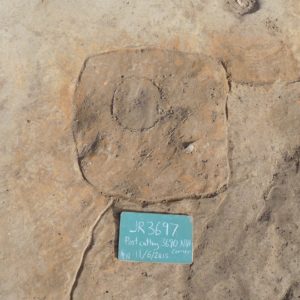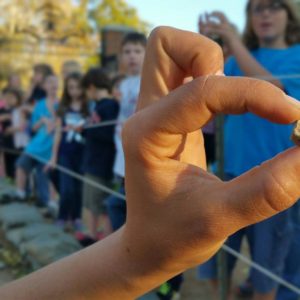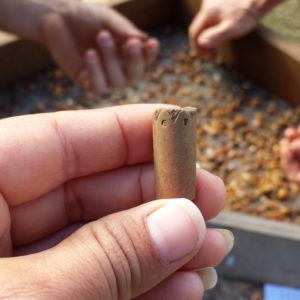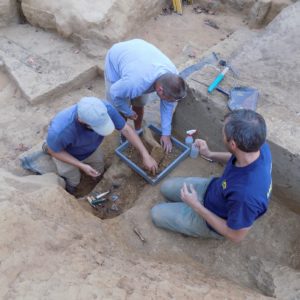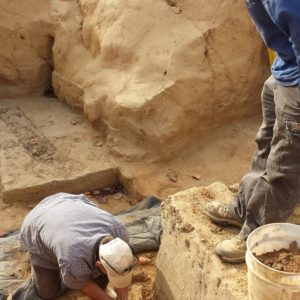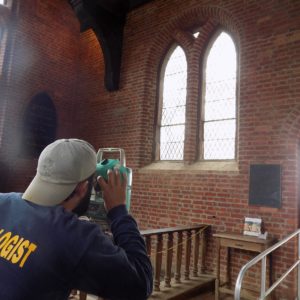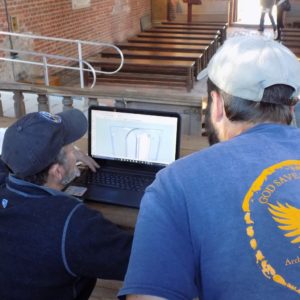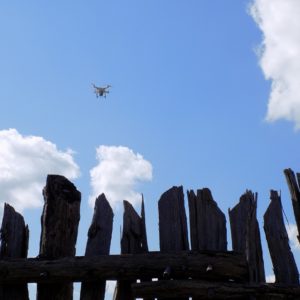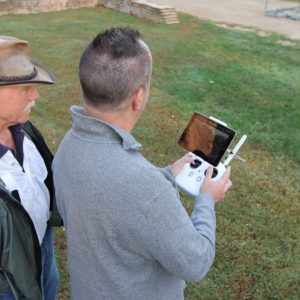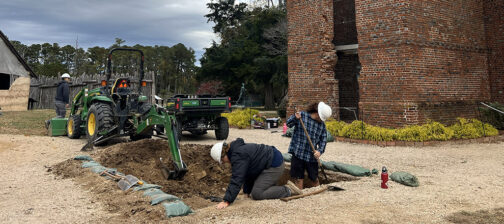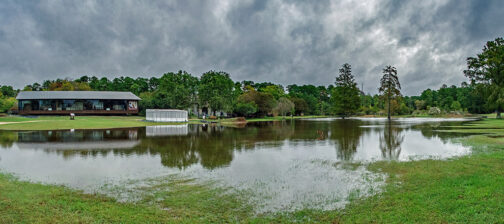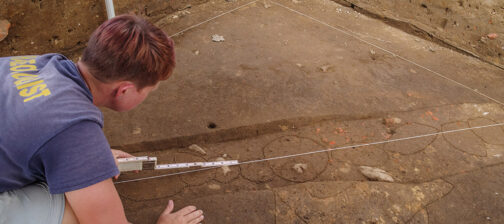An unseasonably warm November afforded Rediscovery archaeologists many good excavation days in the cellar at the northeast corner of the 1608 palisade extension. The crew finished uncovering the cellar’s northeast corner, which helped determine the feature’s north wall. Also, part of the north wall in the cellar was exposed by the complete removal of Pit 27, a large pit cutting the cellar. Only a 5’ x 5’ x 3’ section of fill remains left to remove above the level where the postholes and wood stains start to appear.
Four intrusive postholes were removed from the northwest side of the cellar. One modern, gravel-filled posthole was related to signage around the Pocahontas Statue, which was located in this area until 2014. Two of the other postholes removed may be associated with fence lines heading north that the Rediscovery team has been following over the past year. Both of them were backfilled with brick bits and shell mortar indicating they were dug after the top layers of the cellar were deposited in the mid-17th century. Despite partial excavation of the fourth, a square posthole cutting the cellar fill in its northwest corner, its function remains a mystery. Finds from this posthole include some mid-17th pottery sherds and even a lead die. According to Curator Merry Outlaw, this is only the fourth lead gaming die found at the site. The majority of dice found at Jamestown are bone or ivory.
Several notable artifacts uncovered during the month include a large iron door hinge, additional pieces of iron armor, and an early 17th-century English tobacco pipe stem with tear drop heel. A Robert Cotton pipe stem that had the initials “G F” also was found. Staff archaeologist Mary Anna Hartley commented that, “because we only have the initials stamped on the pipe, we can only speculate for whom this pipe was made. So far, we’ve found three possible gentlemen to whom the letters could refer.” Two possibilities are Giles Francis and George Farmer, who are both listed on the Virginia Company’s second charter in May of 1609. Neither of them is recorded as coming to Virginia. The only one of the three recorded as living at Jamestown is George Forest, who arrived in Virginia with the First Supply in January 1608.
Excavations in the 1907 Memorial Church are planned for the summer of 2016, and in preparation archaeologists are mapping the church’s interior. Senior staff archaeologist Dave Givens stated that, “next year’s research is focused on discovering more about the early churches that stood on the site, including the 1617 church where our nation’s first representative government met in July of 1619.” While some excavations were conducted by Preservation Virginia prior to the construction of the Memorial Church in 1906, records of their findings are sparse. Plans are to dig below the Memorial church’s floor in sections so that the church will remain open to the public during excavations. Givens is using the points collected by our laser transit to create a 3D model of the church that will aid in the planning of exhibits that will accompany the excavations.
Lastly, archaeologist Bob Chartrand’s father, Tom Chartrand of Shoreline Media, donated his services for a couple days to capture drone footage of the site. Archaeologist Danny Schmidt edited some of Chartrand’s footage for this month’s dig update video.
related images
- Bob Chartrand and Chuch Durfor work to remove fill from the northest corner of the cellar in early November.
- Danny Schmidt screens a layer from the cellar with heavy gravel inclusions.
- Lead shot, glass trade beads, a copper straight pin, and a piece of copper scrap found in the trash layers of the cellar.
- Nearing the bottom of Pit 27, a large feature cutting the west end of the cellar.
- A photo looking north, following the exposure of the cellar’s northeast corner.
- One of the intrusive postholes that cut the northeast corner of the cellar after it was backfilled.
- The lead gaming die found in the intrusive posthole.
- Robert Cotton pipe stem stamped with the initials “G F”.
- Archaeologists removing a large piece of iron from the cellar fill. Conservator Dan Gamble will continue to excavate it in the JR lab to determine if it is armor.
- Don Warmke works to expose a large, iron door hinge.
- An early 17th-century English pipe stem with tear drop heel.
- Bob Chartrand maps one of the windows in the 1907 Memorial Church.
- Dave Givens models one of the windows using points from our transit and a program called Trimble “SketchUp.”
- Shoreline Media’s DJI Phantom 3 drone soars above the south palisade wall capturing footage of the fort site.
- Dr. Kelso watches what the drone is seeing as Tom Chartrand flies the drone over the dig site.


